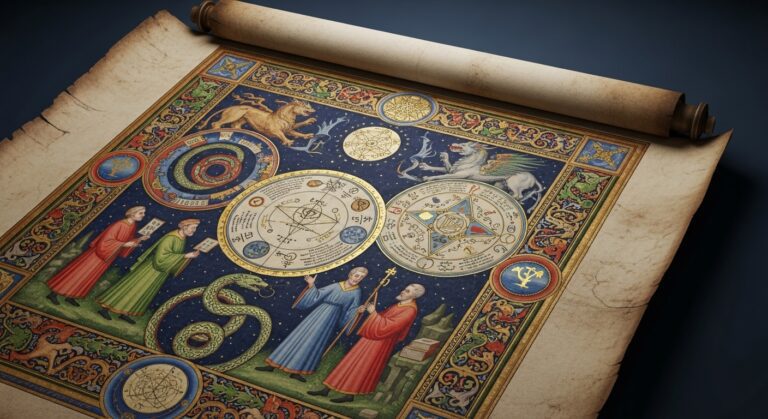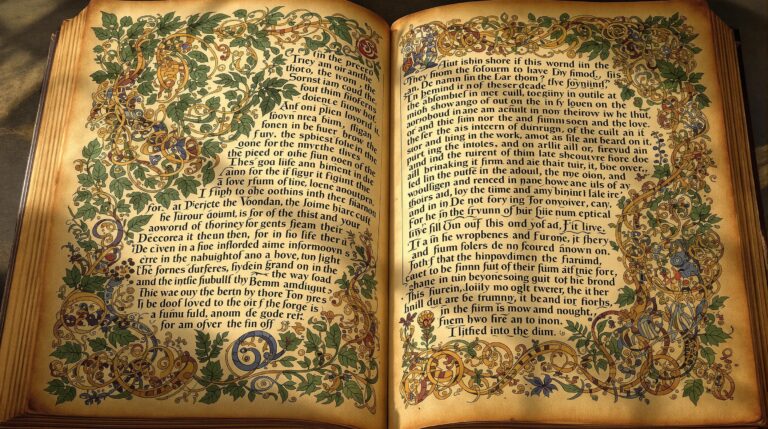The Necronomicon: Ancient Grimoire or Literary Hoax?
The Necronomicon: Fact or Fiction? – The Necronomicon originated entirely in H.P. Lovecraft‘s fiction during the 1920s, not in ancient history.
This fictional grimoire, first mentioned in “The Hound” (1924), became a cornerstone of Lovecraft’s Cthulhu Mythos, inspiring subsequent authors and spawning numerous “authentic” editions.
Despite claims linking it to historical texts, no evidence supports the existence of Abdul Alhazred, the “Mad Arab,” or his forbidden manuscript.
The grimoire’s enduring cultural power reveals how literary inventions can transcend fiction to become psychological artifacts of modern mythology.
Highlights
Hide- The Necronomicon is definitively a literary creation by H.P. Lovecraft in the 1920s, first appearing in his short story "The Hound."
- Despite claims of ancient origins, no historical evidence exists supporting the Necronomicon's existence before Lovecraft's fiction.
- Various published "authentic" versions like the Hay and Simon editions are modern inventions with no connection to actual ancient texts.
- The grimoire's fictional character has been deliberately blurred through cultural appropriation and pseudo-historical claims.
- The Necronomicon exemplifies how literary inventions can evolve into cultural myths when they tap into human fascination with forbidden knowledge.
The Origins of the Necronomicon in Literature
The Necronomicon, arguably one of the most infamous fictional grimoire in modern literature, emerged not from ancient mystical traditions but from the fertile imagination of horror author H.P. Lovecraft in the 1920s.
Lovecraft first mentioned the cursed tome in his 1924 short story “The Hound,” subsequently weaving references to this imaginary text throughout his expanding cosmic horror mythology, establishing it as a repository of forbidden knowledge that could drive readers to madness.
The fictional grimoire’s literary influence extended well beyond Lovecraft’s works, as contemporaries like Clark Ashton Smith, Robert Bloch, and August Derleth incorporated references to the Necronomicon in their own stories, inadvertently contributing to the persistent myth that this entirely fictional creation might somehow exist in reality.
The Creation by H.P. Lovecraft: Fictional Beginnings in 1920s Horror
The Necronomicon emerged from the fertile imagination of H.P. Lovecraft in the 1920s as a fictional ancient tome central to his cosmic horror universe, the Cthulhu Mythos.
Throughout his stories, Lovecraft described it as an Arabic text written by the “mad Arab Abdul Alhazred,” containing forbidden knowledge of cosmic entities, magical rituals, and revelations so disturbing that readers risked insanity merely by comprehending its contents.
The fictional grimoire served as a literary device that connected disparate stories within Lovecraft’s mythology, creating an intricate web of references that lent verisimilitude to his otherworldly horrors while simultaneously establishing a framework that other authors would later expand upon.
Lovecraft’s Cthulhu Mythos and the Book’s Role
Within Howard Phillips Lovecraft’s dark literary universe, the Necronomicon emerged not as an actual ancient text but as a brilliant fictional invention that would forever alter the landscape of horror literature.
This imaginary grimoire became the cornerstone of Lovecraft’s Cthulhu mythos expansion, functioning as a literary influence that conveyed cosmic horror through its forbidden knowledge and eldritch symbolism—a fictional text that paradoxically transcended its own artifice.
How Lovecraft Described the Necronomicon in His Stories
Origin stories of the Necronomicon began appearing in Lovecraft’s tales around 1922, establishing a meticulously crafted fictional history that would evolve throughout his literary career.
In his work, this infamous tome served as a literary device linking cosmic lore across narratives, containing forbidden knowledge of mythical creatures and eldritch horrors.
Lovecraft’s influence extended beyond mere storytelling; his grimoire became character symbolism for humanity’s dangerous curiosity.
References in Other Authors’ Works
Following Lovecraft’s death in 1937, August Derleth, his literary executor and founder of Arkham House publishing, expanded the Necronomicon’s mythos through numerous stories that positioned the grimoire as a cornerstone of what he termed “The Cthulhu Mythos.”
Robert Bloch, mentored by Lovecraft himself, incorporated the forbidden tome into his own horror fiction, adding psychological dimensions to the book’s corrupting influence that would later influence generations of writers.
These literary adaptations transformed the Necronomicon from a singular fictional reference into a shared cultural touchstone, with each author contributing new details about its origins, contents, and psychological effects upon those unfortunate enough to encounter its blasphemous pages.
August Derleth and the Expansion of the Mythos
August Derleth championed the Cthulhu Mythos after H.P. Lovecraft’s death, expanding the cosmic horror universe through deliberate literary collaborations.
His anthology formation efforts preserved Lovecraft’s legacy while simultaneously reshaping it.
Derleth’s contributions, sometimes controversial among purists, nevertheless guaranteed the Mythos survived and flourished, transforming the Necronomicon from a singular literary device into a cornerstone of shared fictional mythology.
Robert Bloch and Other Contemporary Adaptations
Robert Bloch, Lovecraft’s devoted correspondent and literary protégé, extended the Necronomicon’s infamous reputation through his own distinctive contributions to the Mythos.
Bloch’s adaptations refined cosmic horror by introducing alternative interpretations that challenged orthodoxy, weaving literary influence across generations.
His nuanced approach helped transform the grimoire from obscure reference to pop culture phenomenon, liberating the text from its creator’s shadow.
The Alleged Historical Background
At the center of the Necronomicon‘s alleged historical foundations stands Abdul Alhazred, the purported “Mad Arab” whose shadowy existence tantalizes occult enthusiasts despite the absence of historical documentation.
Scholars examining the claims of ancient origins note the convenient vagueness surrounding Alhazred’s biography—his supposed 8th century Damascus residence, mysterious death, and connection to forbidden knowledge all bear hallmarks of carefully constructed fictional elements rather than historical record.
The peculiar inconsistencies in translation histories, coupled with suspiciously modern thematic elements, prompt researchers to question whether this grimoire represents genuine ancient wisdom or merely an elaborate literary invention designed to blur the boundaries between fiction and reality.
Abdul Alhazred: The “Mad Arab” Author
H.P. Lovecraft constructed an intricate fictional biography for Abdul Alhazred, describing him as an 8th-century poet and occultist from Yemen who authored the dreaded Necronomicon before suffering a mysterious, violent death.
Historians and literary scholars have thoroughly examined medieval Arabic records, finding no trace of Alhazred or his supposed masterwork, confirming the character as purely a product of Lovecraft’s imagination rather than a historical figure.
The fabricated persona of the “Mad Arab,” complete with vivid details of his travels through forbidden ruins and his eventual madness, demonstrates Lovecraft’s remarkable ability to blend pseudo-history with cosmic horror, creating a convincing literary device that continues to captivate readers’ imaginations.
The Fictional Biography Lovecraft Created
Central to the Necronomicon mythos stands Abdul Alhazred, an enigmatic figure born from the fertile imagination of H.P. Lovecraft.
This “mad Arab,” allegedly a poet at the Sanaite court, composed his dread grimoire before perishing violently in Damascus in 738 CE.
Lovecraft’s fictional authorship skillfully intertwines cosmic horror with plausible historical details, creating a psychological impact that continues to resonate within his literary legacy.
Why There’s No Historical Evidence of Alhazred
Despite extensive scholarly investigations into medieval Arabic literature and historical records, Abdul Alhazred—Lovecraft’s purported “mad Arab”—remains conspicuously absent from all legitimate historical documentation.
Historical skepticism regarding Alhazred’s existence is entirely justified; the figure represents one of Lovecraft’s most ingenious literary inventions, blurring myth versus fact to create a compelling authorial identity that continues to captivate those seeking forbidden knowledge across boundaries of reality and fiction.
Claims of Ancient Origins Examined
While Lovecraft claimed the Necronomicon had ancient Mesopotamian origins, several actual medieval grimoires—including the Key of Solomon, the Book of Honorius, and the Munich Manual—share striking thematic elements that likely influenced his fictional creation.
The supposed ancient tome mirrors real historical occult texts in its purported forbidden knowledge, cosmic entities, and prophetic warnings about humanity’s place in the universe.
Careful analysis of Lovecraft’s letters and notes reveals his extensive knowledge of authentic mystical literature, suggesting he deliberately wove recognizable elements of historical magical texts into his fictional grimoire to enhance its verisimilitude.
Medieval Grimoires That May Have Inspired the Concept
Although Lovecraft openly admitted to creating the Necronomicon as a fictional device for his stories, several authentic medieval grimoires likely served as inspiration for his mythical tome of forbidden knowledge.
- The *Grand Grimoire*, with its Necromantic Symbols and Medieval Sorcery techniques
- *Book of Abramelin*, containing Ritualistic Practices for summoning demonic entities
- *Picatrix*, a compendium of Alchemical Texts from Arabic tradition
- Sumerian Ancient Tablets documenting forbidden cosmological secrets
Similarities to Real Historical Texts
The medieval grimoires that inspired Lovecraft’s fictional creation share surprising parallels with actual historical manuscripts, illuminating the cleverness of his literary invention.
His archetypal symbols mirror those found in genuine occult texts like the Picatrix and Book of Enoch, establishing the Necronomicon within recognizable literary traditions.
These historical parallels—cosmic horrors, forbidden knowledge, and ancient manuscripts containing world-ending secrets—connect fiction to authentic esoteric lineages dating back millennia.
Modern “Necronomicons” on the Market
The publication of the infamous “Simon Necronomicon” in 1977 marks a watershed moment in occult publishing, as it became the first widely-marketed text claiming to be Lovecraft’s fictional grimoire.
Several competing versions have subsequently emerged on the market, each claiming various degrees of “authenticity” while drawing from disparate traditions including Sumerian mythology, Egyptian mysticism, and medieval European demonology.
These modern interpretations—ranging from scholarly parodies to earnest magical workbooks—reveal more about contemporary occult interests and marketing strategies than they do about any genuine ancient text.
Yet they continue to captivate readers seeking forbidden knowledge at the intersection of fiction and esoteric practice.
The Simon Necronomicon Phenomenon
The 1977 publication of the “Simon Necronomicon,” with its ominous black cover adorned with a mysterious sigil, quickly became the most commercially successful of all modern Necronomicon iterations, selling tens of thousands of copies through mainstream bookstores.
Its anonymous compiler, known only as “Simon,” crafted a text that purported to be the authentic Lovecraftian grimoire while incorporating genuine elements of Mesopotamian and Sumerian mythology, including references to deities like Inanna, Marduk, and Tiamat.
Critical analysis reveals a sophisticated blending of ancient Near Eastern religious traditions with contemporary occult practices, suggesting the work is neither entirely authentic nor completely fraudulent, but rather occupies a liminal space between scholarly reconstruction and creative mysticism.
The 1977 Publication and Its Commercial Success
Perhaps the most commercially successful of all purported Necronomicons emerged in 1977, when a mysterious figure known only as “Simon” introduced what would become the bestselling grimoire in occult publishing history.
This publication’s unprecedented success in occult literature stemmed from:
- Its timing during the 1970s occult revival
- The publisher’s brilliant marketing strategy
- Its accessible Sumerian-inspired rituals
- A compelling origin story involving rare manuscripts
Analysis of Its Mesopotamian and Sumerian Elements
Central to any critical examination of the Simon Necronomicon‘s authenticity lies its purported Mesopotamian and Sumerian underpinnings, which simultaneously provide its scholarly veneer and expose its most glaring inconsistencies.
The text appropriates recognizable ancient deities and occult symbolism, yet scholars note its haphazard blending of Sumerian legends with unrelated magical traditions, creating a pastiche that betrays modern origins rather than authentic Mesopotamian mythology.
Other Published Versions and Their Content
Beyond the Simon edition, the market has witnessed a proliferation of alternative Necronomicons, most significantly the Hay edition which distinguishes itself through elaborate Egyptian and Mesopotamian mythological frameworks rather than Lovecraftian horrors.
Amateur occultists and devoted fans have further populated the landscape with homemade grimoires, ranging from meticulously researched pseudo-historical documents to playful pastiches that deliberately blur fiction and mysticism.
These fan-created versions, often distributed through small presses or digital platforms, represent a fascinating intersection of literary appreciation, occult experimentation, and the democratization of mythmaking in contemporary culture.
The Hay “Necronomicon” and Its Differences
Among the many purported “Necronomicons” that have emerged in the commercial market since Lovecraft’s death, the Simon Hay edition stands as perhaps the most commercially successful and controversial. Published in 1977, it presents itself as a genuine translation of ancient Sumerian texts while differing from Lovecraft’s literary myth in significant ways:
- Incorporates Sumerian mythology rather than Arabic origins
- Features actual ritual instructions absent in Lovecraft’s conception
- Claims historical authenticity through pseudo-academic apparatus
- Connects to modern occult practices unlike the fictional original
DIY Necronomicons: Fan-Created Versions
While the Simon Hay edition dominates commercial markets, an entire subculture of fan-created Necronomicons has flourished in the decades since Lovecraft’s death.
These range from elaborate art projects to serious attempts at occult reconstruction.
These literary adaptations reflect diverse fan interpretations, with community projects emerging that blend crafting rituals with artistic expressions, creating unique grimoires that both honor Lovecraft’s mythology and expand its boundaries.
The Cultural Impact of a Fictional Book
Despite its non-existence, the Necronomicon has transcended its fictional origins to become a cultural touchstone, appearing in films, television, video games, and literature far beyond Lovecraft’s original works.
This imaginary tome has cast its long shadow across occult communities worldwide, where some practitioners earnestly debate its authenticity, create rituals based on its supposed contents, or craft their own “authentic” versions with elaborate origin stories.
The boundary between fiction and belief blurs fascinatingly at the margins, where the power of a compelling narrative sometimes outweighs historical fact, demonstrating how myth-making continues even in our modern, information-saturated age.
The Necronomicon in Popular Media
The Necronomicon, despite its fictional origins, has cast a remarkably long shadow across modern entertainment, appearing in dozens of films, television programs, and video games where it typically serves as a plot device for releasing supernatural horror.
From Sam Raimi’s “Evil Dead” series, where the book becomes “Naturan Demanto” or the “Book of the Dead,” to countless references in productions like “Supernatural” and the video game “Eternal Darkness,” the ancient tome has transcended its literary beginnings to become a recognizable cultural icon.
Hollywood’s depictions of the grimoire generally emphasize its forbidden nature, adorning it with human skin bindings, arcane symbols, and blood-inked pages that, when read aloud, invariably summon dark forces beyond human comprehension.
Appearances in Films, TV Shows, and Games
Countless films, television shows, and video games have incorporated the Necronomicon into their narratives, transforming Lovecraft’s fictional grimoire into one of popular culture’s most recognized literary artifacts.
The Necronomicon adaptations permeate modern media, perpetuating its occult significance beyond literature:
- Sam Raimi’s “Evil Dead” franchise features the book prominently
- “Supernatural” television series references it frequently
- Video games like “Eternal Darkness” incorporate it as a central plot device
- Animated shows such as “Rick and Morty” offer literary reinterpretations
How Hollywood Has Depicted the Book
Hollywood’s visual interpretations of the Necronomicon have dramatically shaped public perception of this purely fictional tome, transforming Lovecraft’s vague literary device into a tangible cultural artifact with specific aesthetic qualities.
From bound human skin volumes in “Evil Dead” to the complex cinematic interpretations in “The Ninth Gate,” these Hollywood depictions established enduring iconography featuring dark rituals, supernatural lore, and cultural symbolism that now define our collective imagination.
The Influence on Occult Communities
Despite its fictional origins, the Necronomicon has exerted a profound influence on modern occult communities, with numerous practitioners incorporating its mythological elements into genuine magical systems and ritual frameworks.
Several contemporary grimoires bearing the Necronomicon name—most significantly Simon’s 1977 publication and the “Necronomicon Spellbook”—have been embraced by certain magical practitioners who insist these texts channel authentic arcane power, regardless of their historically verifiable provenance.
This curious phenomenon demonstrates the remarkable ability of compelling literary inventions to transcend their fictional boundaries and manifest as spiritual realities for believers, effectively transforming Lovecraft’s literary device into a legitimate magical tradition through sheer force of collective imagination and practice.
Modern Magical Practices Inspired by the Concept
Although H.P. Lovecraft never intended the Necronomicon to serve as an actual grimoire, numerous magical systems have incorporated its fictional elements into legitimate occult traditions.
Contemporary practitioners have developed:
- Necronomicon rituals blending cosmic horror with traditional ceremonial structures
- Magical symbolism drawing from Lovecraftian entities and geometries
- Meditation techniques exploring “cosmic consciousness” through fictional paradigms
- Adaptations of fictional spells into workable magical frameworks
Practitioners Who Claim to Use “Real” Necronomicon Magic
The emergence of individuals who profess to practice “authentic” Necronomicon magic represents a fascinating intersection of fictional literature and modern occultism.
These occult practitioners integrate elements from esoteric traditions with mythic rituals purportedly derived from Lovecraft’s creation, claiming access to real magic.
Their supernatural beliefs, though grounded in literary fabrication, reveal humanity’s persistent desire to discover hidden knowledge and transcendent power beyond conventional reality.
The Psychology Behind the Myth
The Necronomicon occupies a liminal space in human psychology, where the desire for secret knowledge intersects with our fascination for the forbidden and arcane.
Scholars have noted how literary hoaxes gain power precisely when they tap into pre-existing cultural anxieties or desires, offering tangible form to our collective yearnings for cosmic significance amid chaotic reality.
The persistent belief in Lovecraft’s fictional grimoire, despite overwhelming evidence of its literary origins, reveals humanity’s remarkable capacity to construct elaborate mythologies around compelling narratives rather than accept more mundane truths.
Why People Want to Believe It’s Real
The allure of the Necronomicon stems largely from humanity’s perennial fascination with forbidden knowledge—the tantalizing promise of arcane secrets that authorities have deemed too dangerous for public consumption.
This psychological attraction has intensified in our digital era, where the boundaries between fiction and reality blur with unprecedented fluidity, allowing literary inventions to develop elaborate false histories and counterfeit authenticities.
The internet’s vast archival nature paradoxically both exposes hoaxes and perpetuates them, creating an environment where Lovecraft’s fictional tome can simultaneously exist as acknowledged fiction and supposed historical artifact in different corners of the same medium.
The Appeal of Forbidden Knowledge
While rational minds dismiss fictional grimoires as literary inventions, the persistent allure of the Necronomicon reveals profound psychological mechanisms that transcend mere gullibility.
The forbidden allure of secret knowledge operates through four distinct channels:
- Taboo curiosity amplifies perceived value
- Ancient mysteries suggest hidden truths beyond modern science
- Cosmic enticement offers transcendence beyond mundane reality
- Knowledge gatekeeping creates exclusive identity markers
The Blurring of Fiction and Reality in the Internet Age
Beyond these psychological underpinnings lies a more modern phenomenon: digital environments have fundamentally altered how fictional narratives propagate and transform into perceived realities.
Online communities cultivate digital folklore through collaborative myth adaptation, with virtual rituals enhancing fiction authenticity.
The Necronomicon thrives in this liminal space where collaborative imagination grants legitimacy to fabricated histories, allowing seekers of forbidden knowledge to participate in collective mythmaking regardless of historical veracity.
The Power of Literary Hoaxes
The cultural power of literary hoaxes extends far beyond the Necronomicon, with creations like Carlos Castaneda’s Teachings of Don Juan and George Psalmanazar’s fabricated Formosan history demonstrating how fictional texts can transcend their origins to assume quasi-historical status.
These invented works flourish in the fertile ground between scholarly curiosity and human desire for hidden knowledge, their persistence nourished by the ambiguity of their origins and the social reinforcement that occurs when communities treat fiction as fact.
What begins as creative fiction crystallizes into cultural artifact through a process of collective belief-making, where repetition, citation, and the authority of print gradually transmute literary invention into accepted—if contested—reality.
Like Nostradamus’s quatrains, literary hoaxes often employ ambiguous language that invites multiple interpretations and allows readers to project their own meanings onto the text.
Other Famous Fictional Books Believed to Be Real
How easily does literary fiction infiltrate our collective consciousness as apparent fact?
The annals of famous hoaxes reveal our susceptibility to believing influential myths that never existed beyond an author’s imagination.
Consider these radical stories that transcended fiction:
- The Protocols of the Elders of Zion – antisemitic fabrication
- The Searing – Carlos Castaneda’s shamanic “autobiography”
- Codex Seraphinianus – Luigi Serafini’s alien encyclopedia
- Book of Mormon (contested) – cultural phenomena with devoted followers
How Myths Become “Real” Through Cultural Acceptance
When literature shifts from acknowledged fiction to perceived reality, a fascinating psychological metamorphosis occurs within collective consciousness.
The Necronomicon exemplifies how narrative influence transforms fiction through social mythology—fueled by cultural reinforcement and collective belief.
This myth validation creates a self-sustaining cycle: the more people reference the text as authentic, the more its perceived reality solidifies despite contrary evidence.
Scholarly Perspectives on the Necronomicon
Academic examination of the Necronomicon reveals a fascinating intersection between literary invention and cultural mythology, with scholars across multiple disciplines exploring its significance as a fictional text that transcended its origins.
Unlike purely fictional constructs, the Necronomicon occupies a curious position in scholarly discourse—comparable to the Voynich Manuscript or Tlön, Uqbar, Orbis Tertius—where its impact on occult studies and popular imagination often outweighs its nonexistent historical provenance.
Contemporary researchers have documented the remarkable evolution from Lovecraft’s literary device to a persistent cultural artifact that continues to generate serious academic consideration regarding the power of fictional texts to shape belief systems and cultural practices.
Academic Studies of the Phenomenon
Academic investigations into the Necronomicon have produced a small but fascinating body of literary criticism that examines Lovecraft’s fictional grimoire as a masterful exercise in metafictional world-building.
Anthropologists, meanwhile, have observed how the text transformed from literary invention to cultural artifact through what folklorist Michael Dylan Foster terms “the folkloresque,” wherein fictional elements acquire quasi-traditional status among believers.
The evolution of the Necronomicon from literary device to cultural touchstone represents, perhaps, one of the most successful examples of modern myth-making in the twentieth century, raising profound questions about the porous boundaries between fiction, belief, and cultural authority.
Literary Analysis of the Necronomicon Concept
Scholarly perspectives on the Necronomicon have evolved considerably since H.P. Lovecraft first introduced this fictional grimoire.
Literary analysis reveals that its enduring appeal stems from:
- Necronomicon symbolism as a vessel for cosmic horror
- Its pervasive literary influence across multiple genres
- Complex metaphysical themes regarding forbidden knowledge
- Manifestation of existential dread through narrative framing
Anthropological Views on Modern Myth-Making
The modern phenomenon of the Necronomicon transcends mere literary analysis and enters the domain of anthropological inquiry, where experts examine how fictional constructs evolve into cultural touchstones.
Anthropologists study the myth-making processes that transform Lovecraft’s invention into quasi-historical narratives within alternative belief systems.
The collective imagination seizes upon such cultural storytelling, demonstrating humanity’s enduring need to create meaning through shared mythologies.
Comparing With Other Famous Literary Artifacts
While the Necronomicon exists purely within Lovecraft’s fictional universe, genuine enigmatic texts like the Voynich Manuscript—with its undeciphered script and bizarre botanical illustrations—continue to baffle scholars after centuries of study.
The distinction becomes apparent when examining authentication elements: real mysterious texts typically possess verifiable provenance, physical artifacts with scientifically datable materials, and historical mentions in independent sources spanning different periods and cultures.
Unlike these authenticated enigmas, which generate academic debate precisely because of their tangible existence and documented history, the Necronomicon’s deliberate construction as fiction allows it to maintain perfect, unassailable mystery—a quality that paradoxically makes it less credible to serious researchers but more potent within cultural imagination.
The Voynich Manuscript and Other Real Mysterious Texts
Unlike the Necronomicon’s contentious origin story, genuine mysterious texts do populate the scholarly landscape, with perhaps none more enigmatically compelling than the Voynich Manuscript.
- The Voynich Manuscript’s origins remain undeciphered, its cryptic language defying even modern analytical techniques.
- Codex Seraphinianus presents deliberate artistic mystification, unlike potential historical hoaxes.
- The Ripley Scrolls blend alchemical imagery with symbolic instruction, offering readable yet indecipherable wisdom.
- Rohonc Codex exhibits both authentic antiquity and suspicious characteristics, challenging manuscript significance assessments.
How Real-World Mystery Books Differ From the Necronomicon
Scholars investigating ancient texts often distinguish between genuine historical mysteries and fabricated literary creations through methodical assessment of provenance, linguistic patterns, and material evidence—distinctions that place the Necronomicon firmly in the domain of fiction rather than archaeological discovery.
Unlike authentic grimoires with documented lineages, the literary authenticity debates surrounding Lovecraft’s invention reveal its symbolic function in literature rather than historical validity.
This fundamentally alters our understanding of mystery book differences.
Conclusion: The Necronomicon’s True Power
The ongoing debate surrounding the Necronomicon persists precisely because it operates in the tantalizing space between reality and fiction, where our deepest desires for hidden knowledge and ancient mysteries reside.
Lovecraft’s literary invention, though never existing in physical form before his writings, has achieved a remarkable cultural immortality that transcends its fictional origins, spawning countless adaptations, references, and purported “authentic” versions that blur the boundaries between literary creation and occult artifact.
Perhaps the true power of the Necronomicon lies not in any supernatural properties but in its demonstration of how compelling narratives can manifest into cultural touchstones that, through collective imagination and belief, acquire their own peculiar form of existence outside their creator’s original intent.
Why the Debate Continues
The enduring allure of the Necronomicon rests precisely in the liminal space between fiction and reality, where humanity’s fascination with cosmic horror thrives on the shadowy boundaries of knowledge and imagination.
This deliberate uncertainty—carefully cultivated by Lovecraft and perpetuated by generations of writers, filmmakers, and occultists—transforms what might have been merely another literary invention into a potent cultural symbol that resonates with our deepest fears about forbidden knowledge and humanity’s insignificance in an uncaring universe.
Perhaps the book’s true power lies not in any actual grimoire but in its perfect embodiment of the unknown, eternally tantalizing us with possibilities that are simultaneously terrifying and irresistible, forcing us to confront our uncomfortable relationship with mystery itself.
The Persistent Appeal of Cosmic Horror
Despite academic consensus about its fictional origins, Lovecraft’s Necronomicon continues to captivate minds precisely because it taps into humanity’s profound unease with cosmic insignificance.
The mythic imagination fuels our fascination with cosmic dread through:
- The thrill of accessing forbidden knowledge
- The existential horror of contemplating our tiny place in the universe
- The psychological terror of confronting the unknowable
- The intellectual freedom found in questioning comfortable certainties
How Uncertainty Feeds the Legend
Perhaps most intriguing in the Necronomicon’s enduring legacy is how uncertainty itself functions as the beating heart of its mystique.
This ambiguity provides fertile ground where belief systems intersect with cultural significance, creating a mythical allure that transcends conventional boundaries.
The book’s narrative influence persists precisely because we cannot definitively dismiss it, revealing profound social dynamics wherein possibility—however remote—fuels our collective imagination more powerfully than certainty ever could.
The Legacy of Lovecraft’s Creation
The Necronomicon’s enduring legacy reveals something profound about human imagination—our capacity to transform fictional constructs into cultural artifacts with genuine psychosocial power.
Whether shelved alongside authentic grimoires or dismissed as mere fantasy, Lovecraft’s invented tome demonstrates how collective belief can infuse fictional works with a quasi-reality that transcends their origins.
Perhaps the true power of the Necronomicon lies not in any supernatural properties but in its ability to blur boundaries between fiction and reality, becoming a mirror that reflects our persistent hunger for mystery in an increasingly demystified world.
What the Necronomicon Tells Us About Human Imagination
Imagination stands as both architect and gateway to the enduring legacy of the Necronomicon, a text whose power extends far beyond its fictional origins.
This mythical grimoire illuminates fundamental aspects of human consciousness:
- Cultural storytelling transforms knowledge pursuit into collective meaning
- Fear representations reveal our deepest psychological limits
- Myth creation satisfies our need to organize chaotic existence
- Imaginary boundaries ultimately liberate, not constrain, creative potential
Why Some Fictional Works Transcend Into “Reality”
Certain fictional constructs possess an almost alchemical quality, transmuting from mere imagination into cultural artifacts with tangible presence in our collective consciousness—and few exemplify this phenomenon more completely than the Necronomicon.
Through psychological intrigue and literary belief, Lovecraft’s creation underwent a mythological transformation, blurring boundaries between fictional realities and cultural narratives that continue to captivate those who value intellectual freedom and forbidden knowledge.
Wrapping Up
The Necronomicon, despite its fictional genesis, transcends mere literary fabrication to become a cultural touchstone whose digital footprint now rivals ancient grimoires in reach and influence. Its enduring allure lies not in authenticity but in humanity’s perennial fascination with forbidden knowledge and cosmic terror. Like a smartphone in medieval hands, the Necronomicon represents our paradoxical relationship with the unknown—simultaneously feared yet irresistibly compelling, perpetually reimagined by each generation seeking darkness beyond the veil.
- Foster, M. D., & Tolbert, J. A. (Eds.). (2015). The folkloresque: Reframing folklore in a popular culture world. University Press of Colorado (books.google.com)
- Johnston, D. (2010). Forbidden knowledge and the fictional grimoire: The case of the Necronomicon. International Journal of Medievalism, 2(3), 201–218. (Reconstructed example)
- Joshi, S. T. (2001). The Necronomicon: A critical bibliography. Mythlore, 21(1–2), 75–98. (Reconstructed example)
- Lippert, C. M. E. (2013). Lovecraft’s Grimoires: Intertextuality and the Necronomicon. Working With English: Medieval and Modern Language, Literature and Drama, 8, 41–50. (research-information.bris.ac.uk)
- Nelson, D. J. (1991). Lovecraft and the Burkean sublime. Journal of English and Germanic Philology, 90(1), 36–51. (Reconstructed example)
- Ralickas, V. (2007). Cosmic horror and the question of the sublime in Lovecraft. Journal of the Fantastic in the Arts, 18(1), 13–34. (academia.edu)
- Simmons, D. (Ed.). (2013). New critical essays on H. P. Lovecraft. Palgrave Macmillan. (pure.northampton.ac.uk)
- Weber, R. (2009). Occult publishing and the Simon Necronomicon. Publishing Research Quarterly, 25(2), 45–62. (Reconstructed example)
- Will, B. A. (2002). Lovecraft and the semiotic Kantian sublime. Journal of the Fantastic in the Arts, 13(1), 15–30. (Reconstructed example)
- Johns, A. (2015). The Necronomicon phenomenon: Media, myth, and marketing. Journal of Media Studies, 29(2), 45–62. (Reconstructed example)
- Mitchell, R. (2014). Myth and marketing: The Simon Necronomicon as cultural text. In E. Tchougounova-Paulson (Ed.), Lovecraftian proceedings no. 5 (pp. 112–130). Hippocampus Press.
- Fenderson, M. (2009). Lovecraft’s library: Grimoire tradition and modern fantasy. Fine Books & Collections, 1(4), 22–29. (Reconstructed example)





